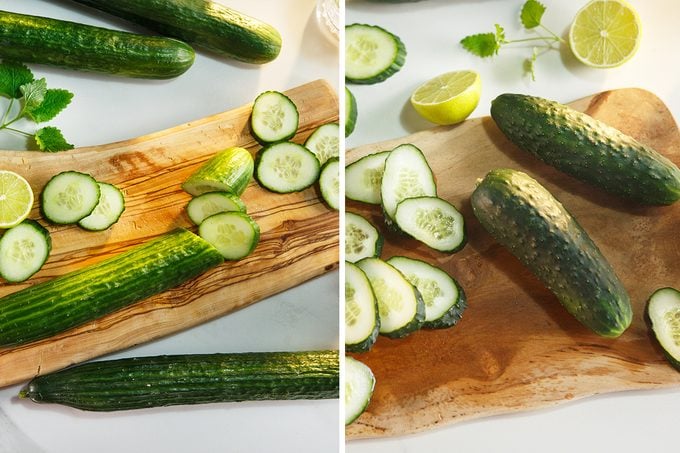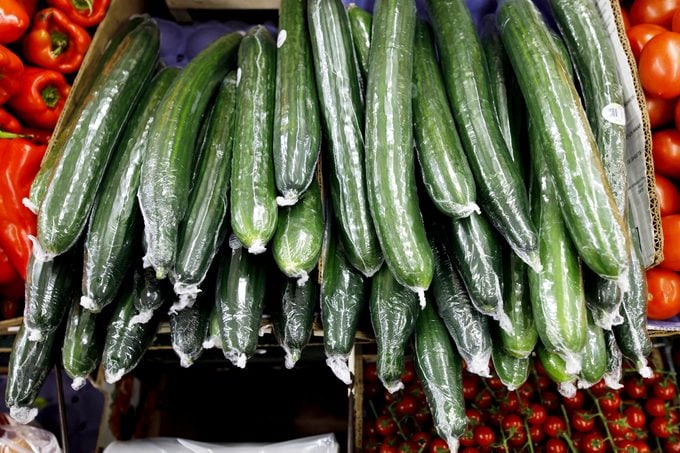What Is an English Cucumber?
Updated: Mar. 06, 2024

An English cucumber is the delicate and refined cousin of the hardy American slicing cucumber. Learn what makes it unique—and superior for tea sandwiches.
Have you ever wondered why one specific type of produce, the English cucumber, is packaged differently from almost every other fruit or vegetable in an American grocery store? Or why these coddled cukes can cost four times as much as their American counterparts? There’s a good reason for it, and once you’re in the know, you might change which variety you reach for in the produce aisle.
What Is an English Cucumber?
English cucumbers are sweet, slender, straight and have fewer, less noticeable seeds than many other cucumbers. You’ll also see them called greenhouse cucumbers, hot house cucumbers, European cucumbers and seedless cucumbers.
Before you move ahead check how to store cucumbers the right way so that you’ll never find a mushy cuke in the refrigerator again.
English cucumbers are about a 14 inches long and about 1-1/2 to 2 inches in diameter. They’re grown off the ground, hanging or on a trellis, to get their characteristic shape. They’re also self-pollinating, which allows them to be grown indoors in greenhouses because they don’t need bees, animals or wind to help them produce seeds and fruit.
At the supermarket, you’ll probably find just one type of English cucumber. At a farm stand or nursery, however, you might find varieties like these:
- English Sweet Long Slim Hybrid Cucumber
- English Long Sweet Crunch Hybrid Cucumber
- Heirloom English Long Telegraph Cucumber
- Chelsea Prize Hybrid English Cucumber
- Sweet Success English Hybrid Cucumber
Cucumbers aren’t the only produce that comes in an English variety. There are English parsnips, watercress, lavender and thyme, too. And English cucumbers are just one of many cukes with a country- or region-specific name. Here are some other cucumber varieties you may have heard of, especially if you’re a gardener:
- Japanese cucumber
- Armenian cucumber
- Persian cucumber
- Mediterranean cucumber
- Chinese cucumber
- Mexican sour cucumber
- Brown Russian cucumber
- Parisian cucumber
We have all these types of cucumbers today because people spread them around the world from the fruit’s origins in India. If you’ve ever had the yogurt-based condiment raita, you’ve experienced one way the cucumber is used in Indian cuisine.
English Cucumber vs Cucumber

The American slicing cucumber is your standard supermarket cucumber in the United States. Compared to an English cucumber, its skin is darker and thicker and its seeds are larger and more plentiful. It’s usually a few inches shorter and may be closer to 2-1/2 inches in diameter. It’s a plumper, sturdier fruit.
An American cucumber tends to have smoother skin, while an English cuke’s skin may be more furrowed. However, you don’t need to peel or seed an English cucumber, whereas you’ll usually want to take these extra steps with an American cucumber to improve the flavor and texture of your dish. These differences help explain why it can be worthwhile to pay more for an English cucumber, especially if you’re highlighting the ingredient in cucumber recipes like tea sandwiches or a balsamic cucumber salad.
Some people also find American cucumbers hard to digest, hence the term “burpless” for English cucumbers.
Why Are English Cucumbers Wrapped in Plastic?

The quickest way to identify an English cucumber at the grocery store is by its shrink wrap. These thin-skinned fruits need the extra protection of plastic so they don’t get bruised or dried out in transit. Tender skin is one of the reasons English cucumbers are less bitter than other varieties. And the plastic is in lieu of the wax coating you’ll often find on American slicing cukes.




















